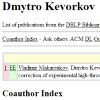|
InBook
publications sorted by year
|
|
|
|
| |
 
R. A. Leo Elworth,
Huw A. Ogilvie,
Jiafan Zhu and
Luay Nakhleh. Advances in Computational Methods for Phylogenetic Networks in the Presence of Hybridization. In
Tandy Warnow editor, Bioinformatics and Phylogenetics. Seminal Contributions of Bernard Moret, Vol. 29 of Computational Biology, Springer, 2019.
Keywords: explicit network, phylogenetic network, phylogeny, Program Dendroscope, Program PhyloNet, Program PhyloNetworks SNaQ, Program PIRN, Program SplitsTree, reconstruction, survey.
Note: https://bioinfocs.rice.edu/sites/g/files/bxs266/f/ElworthZhuOgilvieNakhleh.pdf
|
|
| |

Louxin Zhang. Clusters, Trees, and Phylogenetic Network Classes. In
Tandy Warnow editor, Bioinformatics and Phylogenetics. Seminal Contributions of Bernard Moret, Vol. 29:277-315 of Computational Biology, Springer, 2019.
Keywords: cluster containment, explicit network, phylogenetic network, phylogeny, polynomial, tree containment.
|
|
|
|
|
|
|
|
|
|
| |
  
Vladimir Makarenkov,
Alix Boc and
Pierre Legendre. A New Algorithm for Inferring Hybridization Events Based on the Detection of Horizontal Gene Transfers. In
Fuad Aleskerov,
Boris Goldengorin and
Panos M. Pardalos editors, Clusters, Orders, and Trees: Methods and Applications, Vol. 92 of Springer Optimization and Its Applications, Springer, 2014.
Keywords: explicit network, phylogenetic network, phylogeny, reconstruction.
|
|
| |
|
|
|
|
|
|
|
|
|
| |
|
| |

David A. Morrison. Phylogenetic networks in systematic biology (and elsewhere) In
R.M. Mohan editor, Research Advances in Systematic Biology, Global Research Network, Trivandrum, India, 2010.
Keywords: abstract network, explicit network, phylogenetic network, phylogeny, reconstruction, survey.
|
|
|
|
|
|
| |
  
Luay Nakhleh,
Derek Ruths and
Hideki Innan. Gene Trees, Species Trees, and Species Networks. In
R. Guerra,
D. B. Allison and
D. Goldstein editors, Meta-analysis and Combining Information in Genetics and Genomics, 2009.
Keywords: coalescent, explicit network, from rooted trees, from species tree, phylogenetic network, phylogeny, reconstruction.
Note: http://www.cs.rice.edu/~nakhleh/Papers/GuerraGoldsteinBookChapter.pdf.
|
|
| |
 
Robert G. Beiko and
Mark A. Ragan. Untangling Hybrid Phylogenetic Signals: Horizontal Gene Transfer and Artifacts of Phylogenetic Reconstruction. In Horizontal Gene Transfer, Vol. 532:241-256 of Methods in Molecular Biology, 2009.
Note: http://dx.doi.org/10.1007/978-1-60327-853-9_14.
Toggle abstract
"Phylogenomic methods can be used to investigate the tangled evolutionary relationships among genomes. Building 'all the trees of all the genes' can potentially identify common pathways of horizontal gene transfer (HGT) among taxa at varying levels of phylogenetic depth. Phylogenetic affinities can be aggregated and merged with the information about genetic linkage and biochemical function to examine hypotheses of adaptive evolution via HGT. Additionally, the use of many genetic data sets increases the power of statistical tests for phylogenetic artifacts. However, large-scale phylogenetic analyses pose several challenges, including the necessary abandonment of manual validation techniques, the need to translate inferred phylogenetic discordance into inferred HGT events, and the challenges involved in aggregating results from search-based inference methods. In this chapter we describe a tree search procedure to recover the most parsimonious pathways of HGT, and examine some of the assumptions that are made by this method."
|
|
| |

Maria S. Poptsova. Testing Phylogenetic Methods to Identify Horizontal Gene Transfer. In Horizontal Gene Transfer, Pages 227-240, 2009.
Note: http://dx.doi.org/10.1007/978-1-60327-853-9_13.
Toggle abstract
"The subject of this chapter is to describe the methodology for assessing the power of phylogenetic HGT detection methods. Detection power is defined in the framework of hypothesis testing. Rates of false positives and false negatives can be estimated by testing HGT detection methods on HGT-free orthologous sets, and on the same sets with in silico simulated HGT events. The whole process can be divided into three steps: obtaining HGT-free orthologous sets, in silico simulation of HGT events in the same set, and submitting both sets for evaluation by any of the tested methods.Phylogenetic methods of HGT detection can be roughly divided into three types: likelihood-based tests of topologies (Kishino-Hasegawa (KH), Shimodaira-Hasegawa (SH), and Approximately Unbiased (AU) tests), tree distance methods (symmetrical difference of Robinson and Foulds (RF), and Subtree Pruning and Regrafting (SPR) distances), and genome spectral approaches (bipartition and quartet decomposition analysis). Restrictions that are inherent to phylogenetic methods of HGT detection in general and the power and precision of each method are discussed and comparative analyses of different approaches are provided, as well as some examples of assessing the power of phylogenetic HGT detection methods from a case study of orthologous sets from gamma-proteobacteria (Poptsova and Gogarten, BMC Evol Biol 7, 45, 2007) and cyanobacteria (Zhaxybayeva et al., Genome Res 16, 1099-108, 2006)."
|
|
| |

Gabriel Valiente. Combinatorial Pattern Matching Algorithms in Computational Biology Using Perl and R. Pages 184-208, Taylor & Francis/CRC Press, 2009.
Keywords: counting, distance between networks, galled tree, generation, phylogenetic network, phylogeny, survey, time consistent network, tree sibling network, tree-child network.
Note: http://books.google.fr/books?id=F4YIIUWb7yMC.
|
|
| |
|
|
|
|
|
|
|
|
|
| |

Daniel H. Huson. Split networks and Reticulate Networks. In
Olivier Gascuel and
Mike Steel editors, Reconstructing Evolution, New Mathematical and Computational Advances, Pages 247-276, Oxford University Press, 2007.
Keywords: abstract network, consensus, from rooted trees, from sequences, from splits, from unrooted trees, galled tree, hybridization, phylogenetic network, phylogeny, Program Beagle, Program Spectronet, Program SplitsTree, Program SPNet, recombination, reconstruction, split network, survey.
Note: similar to http://www-ab.informatik.uni-tuebingen.de/research/phylonets/GCB2006.pdf.
|
|
| |
|
| |
|
|
|
|
|
| |
  
Vladimir Makarenkov,
Dmytro Kevorkov and
Pierre Legendre. Phylogenetic Network Construction Approaches. In Applied Mycology and Biotechnology, Vol. 6:61-97, 2006.
Keywords: from distances, hybridization, lateral gene transfer, median network, NeighborNet, netting, Program Arlequin, Program Network, Program Pyramids, Program Reticlad, Program SplitsTree, Program T REX, Program TCS, Program WeakHierarchies, pyramid, reticulogram, split, split decomposition, split network, survey, weak hierarchy.
Note: http://www.labunix.uqam.ca/~makarenv/makarenv/MKL_article.pdf.
|
|
| |
|
| |
 
Guillaume Bourque and
Louxin Zhang. Models and Methods in Comparative Genomics. In
Chau-Wen Tseng editor, Advances in Computers, Special Volume: Computational Biology, Vol. 68, Elsevier, 2006.
Keywords: from distances, from rooted trees, from sequences, galled tree, phylogenetic network, phylogeny, survey.
Note: http://www.math.nus.edu.sg/~matzlx/papers/CompGen_ZLX.pdf.
|
|
|
|
|
|
| |
|
| |
|
| |

David Bryant. Extending tree models to splits networks. In
Lior Pachter and
Bernd Sturmfels editors, Algebraic Statistics for Computational Biology, Pages 322-334, Cambridge University Press, 2005.
Keywords: abstract network, from splits, likelihood, phylogenetic network, phylogeny, split, split network, statistical model.
Note: http://www.math.auckland.ac.nz/~bryant/Papers/05ascbChapter.pdf.
|
|
|
|
|
|
|
|
|
|
|
|
|
|
|
|